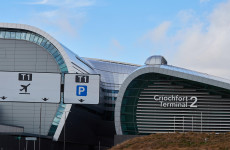Top Stories
Dublin’s MetroLink Faces Criticism Amid Long-Awaited Decision

The debate surrounding the proposed MetroLink in Dublin continues as criticism arises from prominent figures, particularly regarding its cost and purpose. This conversation, which has persisted for over two decades, has reached a pivotal moment as the planning application awaits a long-overdue decision, initially expected in 2024.
MetroLink is envisioned as a vital 19-kilometer metro line connecting Swords, located north of Dublin, through Dublin Airport and into the city centre. The automated line is projected to operate driverless trains every three minutes during peak hours, potentially transporting up to 20,000 passengers in each direction every hour. This capacity significantly surpasses that of the existing Luas Green Line, which can only handle 8,000 passengers per hour.
The project promises to alleviate traffic congestion by removing thousands of cars from Dublin’s roads, making commuting more efficient. However, recent comments from billionaire business leaders like Michael O’Leary, CEO of Ryanair, and Dermot Desmond have reignited the discussion. O’Leary expressed his concerns in a letter to the Irish Times, highlighting two primary objections: the perceived focus on connecting Dublin Airport to the city centre and the projected costs involved.
It is crucial to clarify that while Dublin Airport may emerge as the busiest station along the MetroLink route, the project’s broader objective is to enhance connectivity throughout North County Dublin. According to Brian Caufield, a transport professor at Trinity College, the real benefit lies in providing essential rail access to areas like Swords, which currently lacks a rail link. The MetroLink plans include 16 stops, with an estimated 175,000 residents within walking distance of a station once completed.
The historical context of MetroLink reveals that the project was initially conceived as an upgrade to the existing Luas Green Line, which was designed with this future in mind. The anticipated development of MetroLink would create a high-capacity metro line spanning from north to south Dublin, thus improving public transport in a city grappling with significant traffic issues.
The population in Fingal, the area served by MetroLink, surged by 12% between 2016 and 2022, making it the second-fastest growing county in Ireland. With projections indicating continued growth, the need for an efficient transport system becomes increasingly urgent. Current road networks struggle to accommodate the rising number of vehicles, leading to significant congestion and delays in public transport services.
In addressing O’Leary’s second concern regarding costs, he cited a projected expenditure of approximately €20 billion, which he argued lacks transparency in cost-benefit analysis. However, this figure has been misrepresented; transport officials have suggested that the actual cost range is between €7.16 billion and €12.25 billion, although these estimates may require revision due to inflationary pressures. The higher figure of €23 billion represents an extreme upper limit, assuming all potential setbacks occur.
Delays in the project’s timeline only exacerbate concerns about the eventual cost. As planning permission is expected by the end of this year, the focus should be on expediting the development of MetroLink. Critics of large infrastructure projects often raise questions about cost-effectiveness, yet history suggests that these projects, once completed, often prove indispensable.
The development of MetroLink is poised to play a significant role in transforming Dublin into a more sustainable and less congested urban environment. As the city prepares for a decision on the project, the emphasis must remain on delivering a solution that benefits the growing population and improves overall connectivity. The future of Dublin’s transport infrastructure depends on the successful implementation of MetroLink, which aims not only to connect the airport to the city centre but also to serve as a robust transport backbone for the wider region.
-

 Top Stories3 months ago
Top Stories3 months agoTributes Surge for 9-Year-Old Leon Briody After Cancer Battle
-

 Entertainment4 months ago
Entertainment4 months agoAimee Osbourne Joins Family for Emotional Tribute to Ozzy
-

 Politics4 months ago
Politics4 months agoDanny Healy-Rae Considers Complaint After Altercation with Garda
-

 Top Stories4 months ago
Top Stories4 months agoIreland Enjoys Summer Heat as Hurricane Erin Approaches Atlantic
-

 World5 months ago
World5 months agoHawaii Commemorates 80 Years Since Hiroshima Bombing with Ceremony
-

 Top Stories3 months ago
Top Stories3 months agoNewcastle West Woman Patricia Foley Found Safe After Urgent Search
-

 Top Stories5 months ago
Top Stories5 months agoFianna Fáil TDs Urgently Consider Maire Geoghegan-Quinn for Presidency
-

 World5 months ago
World5 months agoCouple Convicted of Murdering Two-Year-Old Grandson in Wales
-

 World5 months ago
World5 months agoGaza Aid Distribution Tragedy: 20 Killed Amid Ongoing Violence
-

 World5 months ago
World5 months agoAristocrat Constance Marten and Partner Convicted of Infant Murder
-

 Top Stories4 months ago
Top Stories4 months agoClimbing Errigal: A Must-Do Summer Adventure in Donegal
-

 Top Stories4 months ago
Top Stories4 months agoHike Donegal’s Errigal Mountain NOW for Unforgettable Summer Views









